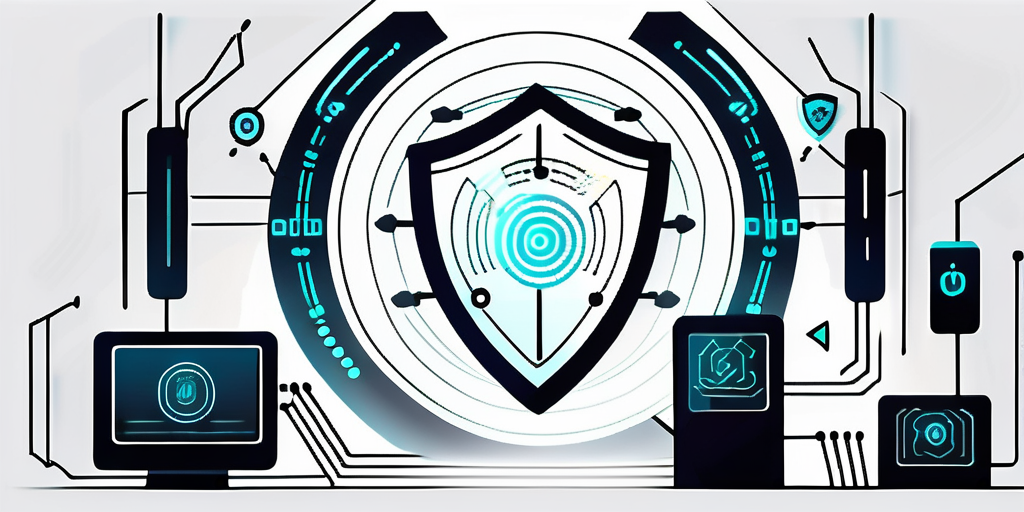Updated April 26, 2025
In the rapidly evolving world of cybersecurity, businesses are constantly seeking new ways to protect themselves from emerging threats. One approach that has gained significant popularity is penetration testing, also known as pen testing. But what exactly is pen testing, and how does it fit into the broader realm of cybersecurity?
Understanding Penetration Testing
Penetration testing involves simulating real-world cyber attacks to identify company systems, networks, and applications vulnerabilities. It helps organizations assess their security posture and determine the effectiveness of their existing defenses. By exposing weaknesses before malicious hackers can exploit them, pen testing empowers businesses to take proactive measures to enhance their security posture.

The Role of Pen Testing in Cybersecurity
Penetration testing plays a critical role in any comprehensive cybersecurity strategy. It goes beyond traditional security measures, such as firewalls and antivirus software, by simulating real-world attack scenarios. This allows organizations to identify the vulnerabilities that hackers can exploit and prioritize their efforts to mitigate these risks.
One of penetration testing’s main benefits is that it provides a realistic evaluation of an organization’s security measures. While firewalls and antivirus software are essential, they cannot guarantee complete protection against sophisticated cyber attacks. Pen testing helps organizations understand the limitations of their existing security measures and identify areas that require improvement.
Penetration testing provides valuable insights into the potential impact of successful cyberattacks. By simulating real-world attack scenarios, organizations can assess the extent of damage that can be caused and develop effective incident response plans. This allows businesses to minimize the impact of potential breaches and ensure business continuity.
Key Components of Penetration Testing
Effective pen testing comprises several key components. The first step is reconnaissance, where the pen tester gathers intelligence about the target systems. This involves collecting information about the organization’s infrastructure, network architecture, and potential entry points for attackers. By understanding the organization’s environment, the pen tester can identify potential vulnerabilities and plan the subsequent stages of the test.
Next is enumeration, where the pen tester identifies system resources and vulnerabilities. This involves scanning the target systems for open ports, services, and software versions. By identifying these details, the pen tester can determine potential weaknesses that can be exploited to gain unauthorized access. Enumeration also helps understand the organization’s network topology and identify possible paths for lateral movement.
Exploitation involves attempting to gain unauthorized access to the target systems. The pen tester leverages the identified vulnerabilities to breach the organization’s defenses. The objective is to simulate a real-world attack and determine the effectiveness of the existing security measures. By successfully exploiting vulnerabilities, the pen tester can demonstrate the potential impact of a cyber attack and highlight areas that require immediate attention.
After successful exploitation, the pen tester then evaluates the impact of the attacks and determines the extent of damage that can be caused. This involves assessing the compromised systems, sensitive data that could be accessed, and potential consequences for the organization. By understanding the impact, organizations can prioritize mitigating the identified vulnerabilities and minimizing the potential damage.
Finally, the pen tester provides a detailed report with recommendations for mitigating the identified vulnerabilities. This report includes a comprehensive analysis of the test results, including the vulnerabilities exploited, the impact of successful attacks, and suggested remediation measures. The report serves as a roadmap for organizations to enhance their security posture and strengthen their defenses against potential cyber threats.
The Concept of Automated Pen Testing
With the ever-increasing complexity and volume of cyber threats, traditional manual pen testing can be time-consuming and costly. Automated pen testing has emerged as a viable alternative to address these challenges. But what exactly is automated pen testing, and how does it differ from manual pen testing?
Automated pen testing, also known as automated penetration testing, is a method of assessing the security of a system or network by using software tools to simulate cyber attacks and identify vulnerabilities. Unlike manual pen testing, which relies on human testers to manually determine and exploit vulnerabilities, automated pen testing utilizes predefined attack techniques and vulnerability databases to scan target systems.
The Evolution of Automated Pen Testing
Automated pen testing has evolved significantly over the past decade. Initially, it focused on automating repetitive tasks in the pen testing process, such as vulnerability scanning. However, technological advancements have led to the development of intelligent tools that can perform more complex tasks and provide a deeper analysis of vulnerabilities.
These advanced tools leverage machine learning algorithms and artificial intelligence to mimic the behavior of real-world attackers. They can identify vulnerabilities manual testers may have overlooked and provide a more comprehensive assessment of the system’s security posture.
Automated pen testing tools have become more user-friendly and accessible, allowing organizations of all sizes to incorporate them into their security testing processes. This has democratized the practice of pen testing, enabling businesses to proactively identify and address vulnerabilities without the need for extensive resources or specialized expertise.
How Automated Pen Testing Works
Automated pen testing utilizes software tools to simulate cyber attacks and identify vulnerabilities. These tools scan target systems using predefined attack techniques and vulnerability databases. They then generate detailed reports with identified vulnerabilities and potential remediation measures. Automated pen testing can be performed regularly to ensure continuous security monitoring.
One key advantage of automated pen testing is its ability to scale and cover a large number of systems within a short period of time. On the other hand, manual pen testing can be time-consuming and may not be feasible for organizations with limited resources or tight deadlines.
Automated pen testing tools can also provide real-time monitoring and alerting capabilities, allowing organizations to promptly detect and respond to potential threats. This proactive approach to security testing can help prevent successful cyber attacks and minimize the impact of any security breaches.
However, it is essential to note that automated pen testing is not a one-size-fits-all solution. While it can significantly enhance the efficiency and effectiveness of security testing, it should be complemented with manual testing to ensure a comprehensive assessment of the system’s security posture.
Myths Surrounding Automated Pen Testing
Despite the numerous benefits of automated pen testing, several myths and misconceptions persist. Let’s debunk some of these myths and shed light on the reality of automated pen testing.
Automated pen testing has revolutionized the way organizations approach security testing. Its ability to quickly scan networks and identify vulnerabilities has made it an essential tool in the fight against cyber threats. However, some common misconceptions remain that need to be addressed.
Common Misconceptions about Automated Pen Testing
One common myth is that automated pen testing can replace manual pen testing entirely. While automated tools can expedite the testing process, they cannot replace human expertise and critical thinking. Manual pen testing is still essential for identifying complex vulnerabilities that automated tools may miss.
Imagine a scenario where an automated tool scans a network and identifies a potential vulnerability. While this is a great starting point, a manual tester can take it a step further by conducting a thorough investigation to determine the severity and impact of the vulnerability. They can also provide valuable insights and recommendations for remediation.
Another misconception is that automated tools can provide a one-size-fits-all solution. Automated pen testing tools should be tailored to each organization’s specific needs and environment to ensure accurate results. Generic tools may overlook unique vulnerabilities specific to a particular system or application.
Every organization has its unique infrastructure, applications, and security requirements. It is crucial to select automated tools that can be customized and configured to meet these specific needs. This customization ensures that vulnerabilities are accurately identified and addressed, reducing the risk of potential breaches.
Debunking the Myths of Automated Pen Testing
Automated pen testing should not be seen as a replacement for manual testing, but rather as a complementary tool. By combining the strengths of both approaches, organizations can achieve a more comprehensive and efficient testing process. Automated tools can rapidly scan large networks and provide an initial assessment of vulnerabilities, while manual testing can delve deeper into specific areas and identify complex vulnerabilities.
Automated pen testing can significantly reduce the time and effort required for security testing. With the ability to scan networks and applications much faster than manual testing, organizations can identify vulnerabilities and address them promptly. This proactive approach enhances the overall security posture and minimizes the risk of potential breaches.
It is important to note that automated pen testing is not a one-time activity. Regular testing and continuous monitoring are crucial to promptly identifying and addressing new vulnerabilities. By integrating automated pen testing into the overall security strategy, organizations can stay one step ahead of cyber threats and protect their valuable assets.
The Reality of Automated Pen Testing

Automated penetration testing, also known as automated pen testing, is a process that utilizes software tools to assess a system or network’s security vulnerabilities. It offers several advantages that organizations can leverage to enhance their security posture.
The Benefits of Automated Pen Testing
Automated pen testing offers several advantages. Firstly, it significantly reduces the time and effort required to assess vulnerabilities, allowing organizations to test more frequently and efficiently. In a world where new threats emerge daily, this is crucial for staying ahead of potential attackers.
Automated pen testing provides a consistent and repeatable testing process. Unlike manual testing, which can vary in quality and thoroughness depending on the tester’s expertise and attention to detail, automated tools ensure that all systems are thoroughly evaluated. This consistency is vital for identifying and addressing vulnerabilities across the entire infrastructure.
Another benefit of automated testing tools is their ability to detect vulnerabilities that manual testers may miss. These tools can scan large volumes of data rapidly, allowing them to identify potential weaknesses that may otherwise go unnoticed. This is particularly important in complex systems where manual testing alone may not be sufficient.
Limitations and Challenges of Automated Pen Testing
Despite its benefits, automated pen testing does have limitations that organizations should be aware of. One of the main challenges is the potential for false positives or negatives. Automated tools rely on predefined algorithms and patterns to identify vulnerabilities, sometimes leading to inaccurate results. Human experts must interpret the findings accurately and determine the true risk level.
Additionally, automated tools may miss more sophisticated vulnerabilities that require manual analysis. While these tools are excellent at identifying common and known vulnerabilities, they may struggle with identifying zero-day exploits or complex attack vectors. With their creativity and adaptability, human testers can often uncover these hidden vulnerabilities that automated tools may overlook.
Automated tools cannot fully simulate the attacker’s perspective. While they can perform a wide range of tests and scans, they lack the intuition and context that human testers bring. Human testers can think like an attacker, identifying potential weaknesses that may not be apparent to an automated tool. This human element is crucial for a comprehensive security assessment.
The Future of Automated Pen Testing
As technology advances, the future of automated pen testing looks promising. Several emerging trends are shaping the landscape of automated pen testing.

Emerging Trends in Automated Pen Testing
One significant trend is the growing integration of artificial intelligence (AI) and machine learning (ML) into automated pen testing tools. These technologies enable the tools to learn from previous tests and adapt their scanning techniques to identify new vulnerabilities. AI and ML can also analyze vast amounts of data and detect patterns that human testers may overlook.
The Role of AI and Machine Learning in Automated Pen Testing
AI and ML can enhance the capabilities of automated pen testing tools by automating vulnerability identification, prioritization, and remediation. They can also help organizations predict potential vulnerabilities and strengthen their security efforts. By harnessing the power of AI and ML, automated pen testing can become even more efficient and effective in identifying and mitigating cybersecurity risks.
Conclusion
Automated pen testing offers a valuable approach to assessing cybersecurity risks but should not be seen as a one-size-fits-all solution. By understanding the reality of automated pen testing and leveraging its strengths while acknowledging its limitations, organizations can implement a comprehensive cybersecurity strategy that strengthens their defenses against evolving threats.
As the cybersecurity landscape continues to evolve, the need for robust and comprehensive security measures has never been greater. Blue Goat Cyber, a Veteran-Owned business, specializes in cutting-edge cybersecurity services tailored for the B2B sector, including medical device cybersecurity, penetration testing, and compliance with HIPAA, FDA, SOC 2, and PCI standards. Our expertise is your frontline defense against cyber threats.
Contact us today for cybersecurity help and partner with a team as passionate about protecting your business as you are.
Automated Penetration Testing FAQs
Automated penetration testing uses specialized tools to simulate cyberattacks on systems, networks, or applications without manual tester intervention, identifying vulnerabilities more efficiently and frequently.
Automated testing uses pre-configured scripts and scanning engines to detect known vulnerabilities quickly. Manual penetration testing, performed by ethical hackers, uses creativity and customized techniques to uncover complex security flaws beyond the capabilities of automation.
Faster vulnerability discovery
Cost-effective for routine assessments
Consistent and repeatable testing
Ideal for continuous security validation in DevSecOps environments
Automated tools may miss complex attack chains, business logic flaws, or newly emerging threats. They also tend to produce false positives that require expert analysis and validation.
No. Automated testing is a valuable supplement but not a replacement. Comprehensive cybersecurity, especially for regulated industries like medical devices, still requires expert manual testing for advanced threat modeling and contextual risk analysis.
Misconfigurations
Known software vulnerabilities (CVEs)
Weak passwords and credential issues
Open ports and insecure services
Common web application flaws (e.g., SQL injection, XSS)
Ideally, automated penetration tests should be run continuously or at least monthly to catch newly introduced vulnerabilities, especially after software updates, device changes, or new system deployments.
Yes. It helps maintain cybersecurity baselines, supports FDA expectations for continuous vulnerability management, and strengthens the security posture of medical device ecosystems between major manual assessments.
Nessus
OpenVAS
Metasploit Pro
Burp Suite (automation modules)
Core Impact
Blue Goat Cyber can help integrate the right tools into your security program based on your medical device architecture and risk profile.
Automated penetration testing supports compliance efforts like FDA cybersecurity guidelines, HIPAA Security Rule, ISO 27001, and NIST frameworks by providing evidence of regular vulnerability assessments and proactive risk management.
